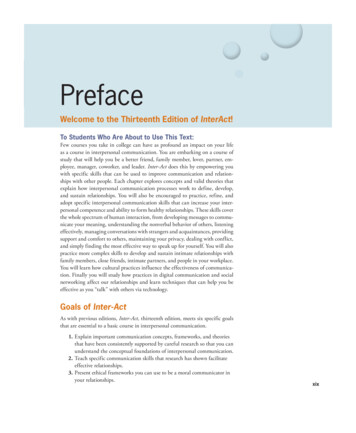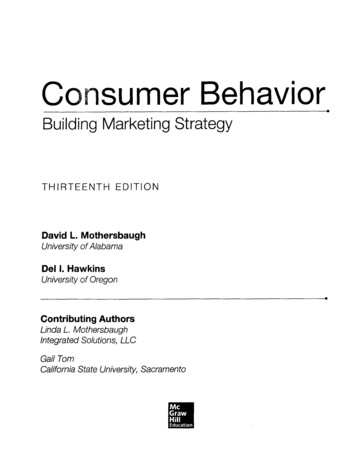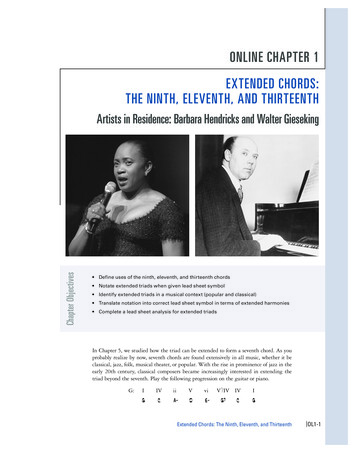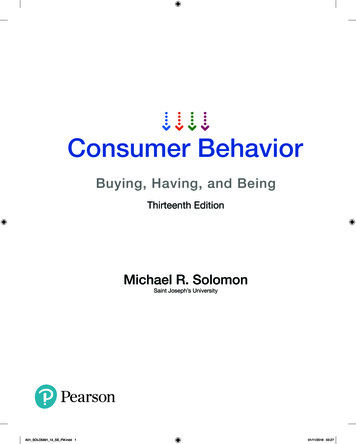
Transcription
PrefaceWelcome to the Thirteenth Edition of InterAct!To Students Who Are About to Use This Text:Few courses you take in college can have as profound an impact on your lifeas a course in interpersonal communication. You are embarking on a course ofstudy that will help you be a better friend, family member, lover, partner, employee, manager, coworker, and leader. Inter-Act does this by empowering youwith specific skills that can be used to improve communication and relationships with other people. Each chapter explores concepts and valid theories thatexplain how interpersonal communication processes work to define, develop,and sustain relationships. You will also be encouraged to practice, refine, andadopt specific interpersonal communication skills that can increase your interpersonal competence and ability to form healthy relationships. These skills coverthe whole spectrum of human interaction, from developing messages to communicate your meaning, understanding the nonverbal behavior of others, listeningeffectively, managing conversations with strangers and acquaintances, providingsupport and comfort to others, maintaining your privacy, dealing with conflict,and simply finding the most effective way to speak up for yourself. You will alsopractice more complex skills to develop and sustain intimate relationships withfamily members, close friends, intimate partners, and people in your workplace.You will learn how cultural practices influence the effectiveness of communication. Finally you will study how practices in digital communication and socialnetworking affect our relationships and learn techniques that can help you beeffective as you “talk” with others via technology.Goals of Inter-ActAs with previous editions, Inter-Act, thirteenth edition, meets six specific goalsthat are essential to a basic course in interpersonal communication.1. Explain important communication concepts, frameworks, and theoriesthat have been consistently supported by careful research so that you canunderstand the conceptual foundations of interpersonal communication.2. Teach specific communication skills that research has shown facilitateeffective relationships.3. Present ethical frameworks you can use to be a moral communicator inyour relationships.Verderber 13 FM.indd19xix5/22/123:44 PM
xxPreface4. Sensitize you as to how communication needs, rules, and processesdiffer among diverse people.5. Challenge you to think critically and creatively about the concepts andskills you learn.6. Provide abundant skills and practice activities that significantly enhanceyour learning.To Instructors Who Have Selected This Text:The skills-based approach that has made Inter-Act so popular over the years hasbeen significantly expanded and reinforced with this new edition. Many of thesechanges are based on our desire to ground the book squarely within the message-centered approach to interpersonal communication (see Burleson, 2010). Amessage-centered approach allows us to explore how people form relationshipsand applies current theories and concepts as a framework for understanding interpersonal communication. The message-centered approach is consistent withthe premise that there are basic universal message skills and guidelines that improve the likelihood of successful human interaction. Inter-Act has always takena skills-based approach to teaching interpersonal communication. This editionintroduces the concepts of canned plans and communication scripts as a way ofunderstanding the mental processes involved in message preparation. Understanding these processes enables students to incorporate new skills into their behavioral repertoire and improve relationships. With this overview in mind, let’stake a closer look at what is new in this edition.New to This Edition Emphasis on Social Media. The book has been strengthened byexpanded discussions of social media and its associated theories, skills,and applications in the realm of interpersonal communication. Tenchapters include new sections called The Social Media Factor thatdiscuss the latest theories, practices, and guidelines for using socialmedia within the context of each chapter. Every chapter includes newmarginal activities called Inter-Act with Social Media. Many chaptersare further enhanced by the addition of new summary questionsand review activities specifically related to digital communication.This balanced approach to the topic was designed to complement thebook’s existing emphasis on understanding, developing, and usinginterpersonal communication skills. Updated discussions on theories and concepts. A key goal for thisedition was to reflect changes to interpersonal concepts found incontemporary research. This is evidenced by many new discussionsin the body of the text. Examples include an emphasis on a messagecentered approach (Chapter 1), the dual processes of social perception(Chapter 2), intercultural communication competence (Chapter 3), theinstrumental, constitutive, and indexical functions of communicationsVerderber 13 FM.indd205/22/123:44 PM
Prefacexxiin relationships (Chapter 6), personal and cultural differences inlistening (Chapter 7), new guidelines for improving conversationalskills (Chapter 8), new suggestions for improving one’s ability toempathize (Chapter 9), discussion of how to effectively ask for feedback(Chapter 10), the use of power to influence others (Chapter 11), faceto-face conflict management versus the use of digital communications(Chapter 12), new and expanded discussions of managing destructiveconflict patterns and forgiveness (Chapter 12), skill clusters that areimportant to sustaining communications in friendships (Chapter 13),guidelines for maintaining a positive climate in intimate relationships(Chapter 13), and new discussions on hiring practices and co-workerrelationships (Chapter 14). Expanded suite of Skill Practice activities. Skill Practice exercisesat the end of every chapter reinforce Inter-Act’s stature as a highlyskills-based text. Dozens of new exercises have been added to thisedition, providing the student with one or more activities for every skilldiscussed in the text. Chapter 3, “Intercultural Communication.” This has been movedforward in response to instructor feedback, re-titled from the lastedition, and revised to discuss the relationships between concepts. Chapter 7, “Listening Effectively.” This has been moved forward inresponse to instructor feedback and now is placed before the chapter onconversation.Hallmark Features of Inter-Act—Strengthened and Revised Chapter openers. Each chapter opens with a practical set of goals forthe student and a sample conversation to set the scene for key ideas to bediscussed. These fictional opening conversations have been reconceivedfor this edition and rewritten for all of the chapters. The conversationsrevolve around a recurring set of college-age students. What unifiesthis diverse group is that they are all taking the same interpersonalcommunication course. Running chapter features. Each chapter includes several unobtrusivefeatures that reinforce learning by engaging the student. Key Terms anddefinitions are highlighted in the margins. Observe and Analyze activitiesask students to observe common communication situations and analyzethem using the concepts and theories that have just been presented inthe text. New Inter-Act with Social Media activities direct students tothink about how basic interpersonal processes are affected when weuse social or electronic media. Instructors can assign these activities asgraded exercises or as prompts for journal entries. Chapter Box features. A variety of special boxes highlight otherperspectives on interpersonal communication. Diverse Voices includeVerderber 13 FM.indd215/22/123:44 PM
xxiiPreface Verderber 13 FM.indd22excerpts of previously published articles that shed light on thecommunication experiences of people from a wide range of backgroundsand cultures. A Question of Ethics: What Would You Do? is a box thatoutlines ethical challenges and requires students to think criticallyabout a variety of ethical dilemmas faced by communicators. Each ofthese kinds of boxes now features a set of critical thinking questions tohelp the student apply what they’ve read. Many chapters feature a selfadministered poll called Learn About Yourself, an opportunity for thestudent to assess their own communication skills within the context ofthe chapter. Instructors may choose to assign these optional boxes forextra credit or use them to launch class discussion.Spotlight on Scholars. Once a box in the chapters, Spotlight on Scholarshas been updated and moved to the book’s companion Web site. Theseshort essays highlight the interested work of leading scholars in thefield. These are of particular interest to individuals who are consideringa career in communication research. The student is reminded of theseWeb entries by a marginal note in associated chapters.Skill Builders. These entries, found in the many chapters, underscorethe skills-based emphasis of Inter-Act. Each Skill Builders entryhighlights a specific definition of a skill, provides a brief description ofits use, explains the steps for enacting the skill, and includes an exampleto illustrate its use.Inter-Action Dialogues and Analyses. Found at the conclusionof Chapters 7 through 12, Inter-Action Dialogues and Analyses area special interactive feature with a video component. Each chapterfeatures a dialogue to illustrate specific skills presented in the chapter.Transcriptions of the conversations are printed in the chapter. Thebook’s companion Web site, at www.oup.com/us/verderber, includes theassociated video footage of the conversations as well as a worksheet forthe student to record their analysis. One of the analyses is provided onthe Web site. The resulting worksheet may be e-mailed to the instructorfor assessment. These conversations can be used for class discussion or asanalytical assignments.End-of-chapter resources. These begin with a Summary of keytakeaway concepts from the chapter and bullet points indicating whatthe student should be able to explain and do after reading the chapter. Alist of Key Words and page numbers enables the student to quickly scanthe chapter for key concepts. This is followed by two sets of activities.Apply Your Knowledge includes activities that challenge students toapply the concepts, theories, and skills that they have used to understandor improve a communication situation. As part of this, Chapters 7–12each include the transcript of an Interaction Dialogue that students canuse to identify and diagnose what is happening in a conversation. At thebook’s companion website, at www.oup.com/us/verderber, students willfind an associated video clip of the conversations as well as a worksheet5/22/123:44 PM
Prefacexxiiithey can use to record their analysis. The resulting worksheet may beemailed to the instructor for assessment or these activities may be assignedas homework and used as the basis for class discussion. At the websitestudents will also find an example of completed analysis. Skill Practiceactivities are short drills that students may complete as they work toincrease their ability to use the specific communication skills presented inthe chapter. There is one of these activities for every skill discussed in thetext. These may be assigned as written activities or used as part of in-classpractice. A Communication Improvement Plan for each chapter helpsstudents set a goal for improving some aspect of their communication.The companion website includes a handy form that can be downloadedto record a plan. Inter-Act with Media provides additional reinforcementfor chapter concepts by using television programs and movies as contentrelated examples. Instructors might assign one of these to the class and useit as the basis for a class discussion or assessment activity. Skill Builders Chart. As an additional convenience for the reader, weprovide a tear-out chart at the beginning of the book including all of thebook’s Skill Builders entries.Significant Content UpdatesIn addition to new and enhanced features, every chapter has been revised to reflect current theory, scholarship, and ways that social and technological changeare affecting our communication and relationships.Chapter 1: “An Orientation to Interpersonal Communication,” hasbeen reorganized and significantly revised to reflect a messagecentered philosophy of interpersonal communication. The chapterbegins by defining interpersonal communication and uses the partsof that definition as the framework for organizing the chapter. Thechapter includes a new Social Media Factor section: UnderstandingSocial Media and Interpersonal Communication. New figures includeFigure 1.1, A Model of Communication Between Two Individuals,Figure 1.2, Understanding Dark Side Messages, Figure 1.5, TheEvolution of Social Networking Technology, and Figure 1.6, AContinuum of Media Richness.Chapter 2: “Forming and Using Social Perception,” has been streamlinedand reorganized into three main points: The Perception Process,Perceiving Others, and Self-Perception: Self-Concept and Self-Esteem.Information on self-presentation has been moved to Chapter 8 “HoldingEffective Conversations.” The chapter includes a new Social MediaFactor section: Human Factors in Using Social Media.Chapter 3: “Intercultural Communication,” has been moved forward,re-titled from the previous edition, and has been revised to clarifythe relationships between concepts. A new section on interculturalVerderber 13 FM.indd235/22/123:44 PM
xxivPrefacecommunication competence has been added. The chapter includes thenew Figure 3.2, The Pyramid Model of Intercultural Competence.Chapter 4: “Verbal Messages,” is major revision. This chapter introducesstudents to linguistics and the different ways the verbal parts ofmessages may be effective or ineffective. The chapter includes new andrevised figures for Figure 4.1, Improving Message Semantics throughClear and Specific Language, Figure 4.2, Improving Semantic Accuracyby Dating Messages, and Figure 4.3, Improving Semantic Accuracy byIndexing Messages.Chapter 5: “Nonverbal Messages,” has been revised and updated to reflectnew scholarship.Chapter 6: “Communication in the Life-Cycle of Relationships,” has anew title that reflects the major revisions to what was previously Chapter3. The chapter begins with a new discussion of how communicationfunctions in a relationship: instrumental, constitutive, and indexical.Next the types of relationships are described, categorized, and thedimensions of relationships are discussed. The life cycle of relationshipsis explained beginning with a discussion on how relationships changeshappen: incrementally and suddenly. The chapter includes a new SocialMedia Factor section: Social Media and Relationship Closeness.Chapter 7: “Listening Effectively,” has been moved forward and is placedbefore the chapter on conversation. The chapter begins with a discussionof the dual approaches that we take when listening: reflexive or activelistening. The chapter includes a new Social Media Factor section:Digital Listening Skills.Chapter 8: “Holding Effective Conversations,” has been substantiallyrevised. The chapter begins with an overview of conversations includinga definition, discussion of the characteristics of a conversation, anddescription of the types of conversations. Much of the chapter focuses onspecific guidelines that can improve our general conversational skills. Thechapter includes a new Social Media Factor section: Digital ConversationSkills. There is a new Figure 8.1, Twenty-Nine Types of Conversation.Chapter 9: “Supporting Others,” has been updated and undergonesome organizational changes. Added to the discussion of empathy arespecific guidelines for improving our ability to empathize. The chapterincludes a new Social Media Factor section: Using Social Media toOffer Empathy and Support. There is a new Figure 9.1, Types of SocialSupport Messages.Chapter 10: “Communicating Personal Information: Disclosure andPrivacy,” has been updated and the section on Asking for Feedback hasbeen substantially revised. The chapter includes a new Social MediaFactor section: Digitally Managing Your Personal Information. ThereVerderber 13 FM.indd245/22/123:44 PM
Prefacexxvis a new Figure 10.1, Risk and Benefits of Disclosure and MaintainingPrivacy.Chapter 11: “Using Interpersonal Influence,” has been substantiallyrevised. The discussion of power now includes references to howwe can use each source of power directly or indirectly as we seek toinfluence others. The discussion of interpersonal influence begins byusing the Elaboration Likelihood Model of Persuasion to explain thatwe can process influence attempts automatically or consciously. We thendiscuss the heuristics (compliance gaining strategies) in messages thatappeal to automatic processors and the ways that extensive processorsevaluate persuasive messages (quality of the reasoning, credibility ofthe speaker, and appropriateness of emotional appeals). The section onAssertiveness has been substantially revised.Chapter 12: “Managing Conflict,” has been revised to highlight differentcultural approaches to disagreement. A new discussion addresses therole that face negotiation plays in conflict including cultural differencesin the meaning of face and uses face negotiation theory to explain howculture and co-culture influence our personal conflict style preferences.New guidelines are provided for breaking destructive conflict patterns,and an expanded section on forgiveness offers specific guidelines andskills that can help repair the damage done to a relationship. Thechapter includes a new Social Media Factor section: Managing theDark Side of Digital Communication.Chapter 13: “Communicating in Intimate Relationships,” has beenrefocused to emphasize how communication patterns and skills affectintimate relationships. The chapter concludes with new material on the“dark side” of intimacy (relational uncertainty and possessiveness) andpresents how effective communication can overcome these dark sidetendencies. The chapter includes a new Social Media Factor section:Using Digital Communication Skills to Improve Relationships. There isa revised Figure 13.1, Common Family Structures.Chapter 14: “Communicating in the Workplace,” has been revised withnew discussions. The section on the hiring process has been updated toreflect current practice that uses online job postings, company research,and application processes. The section on co-worker relationship has newcontent on the types of co-worker relationships and the communicationpatterns in each type. The chapter concludes with new material on the“dark side” of workplace relationships including aggression and sexualharassment. The chapter includes a new Social Media Factor section:Digital Communication Skills in Professional Relationships. New andrevised figures for Figure 14.1, Sample Chronological Resume, Figure14.2, Sample Functional Résumé, Figure 14.3, Sample Cover LetterE-mail, and Figure 14.4, Commonly Asked Interview Questions.Verderber 13 FM.indd255/22/123:44 PM
xxviPrefaceSupplementary MaterialsAs a reader of this text, you also have access to supplementary materials for bothstudent and faculty.Student Materials The Student Success Manual, written by Leah Bryant of DePaulUniversity, is a printed supplement that will help students master thecourse material. It features study tips, chapter outlines and summaries,review questions and answers, key terms, and critical thinking exercises.The companion Web site, www.oup.com/us/verderber, offers a wealth ofresources for both students and instructors, including online self-testingand other study aids, links to a variety of communication-related Websites, and “Now Playing,” reviews of recent films (see print version below). Now Playing: Learning Communication through Film, availableas an optional printed product, looks at more than 60 contemporaryand classic feature films through the lens of communication principles.Developed by Russell F. Proctor II and revised by Darin Garard ofSanta Barbara City College, Now Playing illustrates a variety of bothindividual scenes and full-length films, highlighting concepts andoffering discussion questions for a mass medium that is interactive,familiar, and easily accessible.Faculty Materials The Instructor’s Manual is available in print and is also included on theaccompanying Instructor’s Resource CD provided to adopters of the text.Revised by Jennifer Pitts of Volunteer State Community College, itprovides teaching tips, exercises, and test questions that will prove usefulto both new and veteran instructors. The Instructor’s Manual includespedagogical suggestions, sample syllabi, content outlines, discussionquestions, chapter activities, simulations, and journal assignments. Thecomprehensive Test Bank offers approximately 400 exam questions inmultiple-choice, true/false, and essay formats. The Instructor’s Resource CD with Computerized Test Bank, availableto adopters, includes an electronic copy of the Instructor’s Manual, acomputerized test bank, and newly revised PowerPoint -based lectureslides by Jennifer Pitts of Volunteer State Community College. The Instructor’s Companion Website at www.oup.com/us/verderber is apassword-protected site featuring the Instructor’s Manual, PowerPoint based lecture slides, and links to supplemental materials and films. Now Playing: Instructor’s Edition, an instructor-only print supplement,includes an introduction on how to incorporate film examples in class,more sample responses to the numerous discussion questions in thestudent edition of Now Playing, viewing guides, additional films, andreferences.Verderber 13 FM.indd265/22/123:44 PM
Prefacexxvii Course cartridges for a variety of e-learning environments allowinstructors to create their own course Web sites with the interactivematerial from the instructor and student companion Web sites. Contactyour Oxford University Press representative for access.AcknowledgmentsI was very fortunate to have the late Brant Burleson and Erina MacGeorge ofPurdue work with me as content consultants in planning this edition. I haveadmired both of their scholarship and was honored to spend precious timewith them during the summer of 2010 planning this edition. Their helpfulguidance about content greatly informed my writing for this extensive revision. I am also indebted to Professor MacGeorge for her work revising bothChapter 8 on Conversational Basics and most of Chapter 13 on Intimate Relationships. Joseph Mazer of Clemson University, whose scholarship includesoriginal research on social media and digital communication, drafted the newSocial Media Factor sections found in most chapters, provided the Inter-Actwith Social Media activities found in the margins, and revised the Inter-Actwith Media exercises at the end of each chapter. Joe is gifted at translating theresearch in this area and making it accessible to students. It was a pleasure tolearn from and work with him.While writing can be a solitary activity, I am blessed to have worked withan outstanding team of professionals at Oxford University Press. I was delightedto have the opportunity to work with John Challice, who is the publisher forHigher Education at Oxford, USA, in planning this edition. His wisdom andviewpoint helped me to identify new themes that have been woven into this newedition. Thom Holmes, Development Manager, was the development editor forthis project. His calm persona and editing expertise, as well as his project management skills, were deeply appreciated. Mary-Ann McHugh provided additionaldevelopment editing and her expertise was greatly appreciated. As I was preparingthis edition, Mark T. Haynes became the Communication and Journalism editor.His work in launching this edition has been invaluable. Assistant editor CaitlinKaufman and editorial assistant Kate McClaskey were instrumental in makingthe photo program a success and in obtaining permissions. I am also grateful forthe fine job of the production group: our managing editor, Lisa Grzan; projectmanager, Kate Scully; art director, Michele Laseau, and copyeditor Deanna Hegle.In addition I’d like to thank others who helped in preparing the learningmaterials that accompany this edition including Leah Bryant, Jennifer Pitts, andEllen Bremen. I am also grateful to the following colleagues across the disciplinewho reviewed the twelfth edition and provided me with useful suggestions abouthow to improve this edition:Ken Bush, Norwich UniversitySakile Camara, California State University at NorthridgeAnita Chirco, Keuka CollegeVerderber 13 FM.indd275/22/123:44 PM
xxviiiPrefaceKatie Dunleavy, La Salle UniversityKatrina Eicher, Elizabethtown Community and Technical CollegeGail Hankins, Wake Technical Community CollegeDaniel Hebert, Springfield Technical Community CollegeCarlton Hughes, Southeast Kentucky Community/Technical CollegeKelly Jones, Pitt Community CollegeDavid Majewski, Richard Bland CollegeStan McKinney, Campbellsville UniversityTimothy Moreland, Catawba CollegePaul Sanders, West Valley CollegeJulie Simanski, Des Moines Area Community CollegeCynthia Stevens, Georgia Perimeter CollegeRenee Strom, St. Cloud State UniversityDennis Sutton, Grand Rapids Community CollegeKathie Wilcox, Lewis-Clark State College–Coeur d’AleneAlesia Woszidlo, University of KansasHenry Young, Cuyahoga Community CollegeI would like to thank the various members of our family who have alwayssupported Rudy and me in this work. Their love and encouragement has sustained us.This edition is dedicated to my husband, Rudy, who is no longer able to actively author, but whose imprint on this book and on all basic textbooks in ourfield will be felt for many years to come.Kathleen S. VerderberVerderber 13 FM.indd285/22/123:44 PM
Chapter 1: “An Orientation to Interpersonal Communication, ” has been reorganized and significantly revised to reflect a message-centered philosophy of interpersonal communication. The chapter begins by defining interpersonal communication and uses the parts of that de










